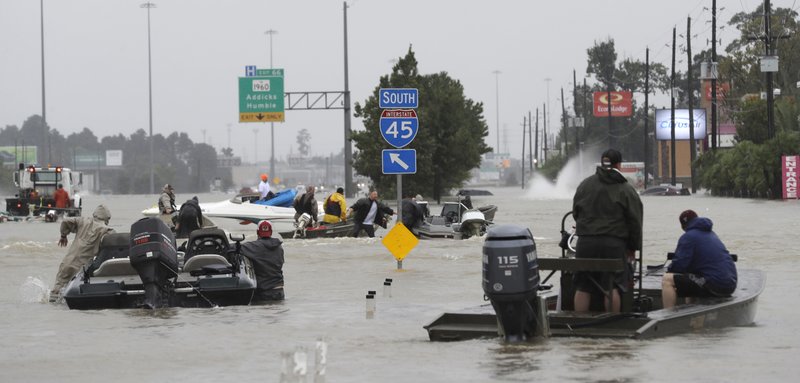More than a dozen central Arkansas hospitals were told by authorities that they could receive patients from the greater Houston area in the aftermath of Harvey ravaging the Texas coastline, though details are sparse on how many or when.
Fifteen Little Rock area hospitals have an agreement with the National Disaster Medical System, said Eric Kindsfater, emergency management coordinator at Conway Regional. The federal program works to supplement medical services and resources whenever natural disasters strike and overwhelm local facilities.
Responding hospitals in central Arkansas include the Conway system; UAMS Medical Center in Little Rock, Baptist Health in Little Rock and North Little Rock; and CHI St. Vincent, among others.
Hurricane Harvey made landfall Friday and has since decimated businesses, drowned streets and flooded neighborhoods in southeast Texas. Anywhere between 500 to 1,800 patients need to be transported from the waterlogged area, based on current estimates, said Diane Hughes, the director of emergency preparedness for UAMS.
Up to 250 of those people could end up in Arkansas, Kindsfater said, quoting an estimate from the federal group.
Oklahoma City is scheduled to receive patients first, with the greater Little Rock area slated as second on the list, Hughes said. Other regions, including Nashville, are accepting people.
As of Wednesday morning, participating Arkansas hospitals were put on alert but have not been “activated,” meaning they do not yet know if any patients are coming or when they might arrive, Hughes said. Officials with the National Disaster Medical System make that decision.
Hughes said there’s a “good possibility” patients will be sent to Arkansas, adding there is no estimate on when hospitals might be notified.
“We believe an activation is imminent,” Kindsfater said. “The number of patients, that’s a real fuzzy number.” He added that it depends on how many people Oklahoma can handle as well as what Texas needs.
“It’s a huge process, logistically speaking," he said.
[LATEST ON HARVEY: Find all storm updates here]
Central Arkansas hospitals were communicating with each other and disaster officials for the past few days to make a plan, said Dr. Richard Turnage, chief executive of UAMS. He said UAMS has internally discussed physical infrastructure needs, staffing levels, the possibility of overtime and bed availability.
Roughly 450 beds are in use 90 to 100 percent of the time at the academic hospital, said Dr. Steppe Mette. That number does not include the thousands of people treated in out-patient care, he said.
UAMS is not currently setting aside beds for Harvey patients because they don’t want to turn local patients away, Turnage said, noting that the number is constantly monitored.
Central Arkansas hospitals must also prepare to treat patients for whom they “don’t know any of the particulars,” Turnage said.
Many Texas patients will have been treated for a generic illness, like pneumonia or are rehabilitating from surgery, Kindsfater said. Some who are in critical condition will be flown in on fixed-wing planes that carry just a handful of people, Hughes said. The rest will arrive on military aircraft that support about 35 people each, Kindsfater said.
UAMS, in coordination with the federal agency, has set up an “entry point” at the Bill and Hillary Clinton National Airport/Adams Field in Little Rock in preparation, Hughes said. EMTs, nurses, doctors and ambulances will await descending planes when they are scheduled to arrive, she said.
When a plane lands, medical staff will board it to triage the patients, Kindsfater said. Representatives from each hospital will wait in a hangar and help direct patients to different facilities based on their condition, their specific illness and bed space, he said.
[STORM TRACKER: Follow Harvey’s projected path]
“From a disaster perspective, we’re kind of in a good spot because we have notification,” Kindsfater said. “This isn’t going to hit us out of the blue like a tornado would.”
The state Department of Health is also readying to help if and when the Texas patients are greenlit, said Marisha DiCarlo, director of communications. The type of services the state will give depends on the type of disaster, she said.
When Katrina hit, many refugees shipped to Arkansas needed shelter as well as medical attention, she said. This time, health care seems to be the focus, she said.
A former version of this story misstated the role of the state Department of Health.
